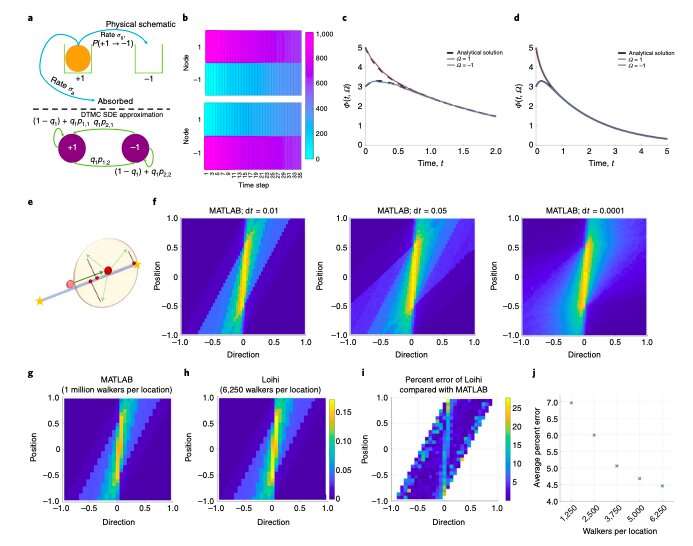Particle simulations on neuromorphic hardware. Credit: Darby Smith et al.
Over the past decade or so, many researchers worldwide have been trying to develop brain-inspired computer systems, also known as neuromorphic computing tools. The majority of these systems are currently used to run deep learning algorithms and other artificial intelligence (AI) tools.
Researchers at Sandia National Laboratories have recently conducted a study assessing the potential of neuromorphic architectures to perform a different type of computations, namely random walk computations. These are computations that involve a succession of random steps in the mathematical space. The team's findings, published in Nature Electronics, suggest that neuromorphic architectures could be well-suited for implementing these computations and could thus reach beyond machine learning applications.
"Most past studies related to neuromorphic computing focused on cognitive applications, such as deep learning," James Bradley Aimone, one of the researchers who carried out the study, told TechXplore. "While we are also excited about that direction, we wanted to ask a different and complementary question: can neuromorphic computing excel at complex math tasks that our brains cannot really tackle?"
The computer science community had so far excluded the possibility that brain-like computer systems would perform well on complex mathematical tasks. The recent study by Aimone and his colleagues shows that, contrary to expectations, this might be the case. More specifically, the team found that the chips might also be promising to simulate discrete-time Markov Chains (i.e., a renowned physics model) using random walk computations.
"We basically recognized that the brain (and thus neuromorphic computing) has a different type of parallel computing architecture than conventional computers," Aimone explained. "When we looked across the many types of scientific computing problems, we recognized that Monte Carlo random walks are a particular class of problem that could naturally fit neuromorphic architectures, if we were clever about reframing the random walk math to fit these platforms."
The team behind the recent study included mathematicians, computer engineers, and Aimone, who is a theoretical neuroscientist. Combining their expertise, the researchers were able to examine Monte Carlo simulations, which have so far been primarily implemented using conventional computing tools, in the context of neuromorphic computing. This allowed them to demonstrate the potential of neuromorphic architectures for completing a renowned complex mathematical task that might have a 'neuromorphic advantage'.
Aimone and his colleagues showed that neuromorphic hardware is more energy-efficient than other systems, as it can perform more random walk calculations per Joule than conventional CPUs and GPUs. In addition, while neuromorphic chips are still slower than existing CPUs and GPUs, the team found that this difference in speed decreases as problems get bigger and more complex.
"Given that neuromorphic hardware continues to improve at a rapid pace and larger systems will soon be available, we expect that this advantage will continue to grow for bigger problems," Aimone said. "There are many real-world applications that use Monte Carlo random walk models as part of their computational workload, including computational biology, materials science, financial modeling and artificial intelligence. However, often these models are computationally expensive to run, which has huge energy, time and financial costs."
Neuromorphic hardware is still in its early stages of development, but they are set to gradually become readily available and easier to program. Once this happens, the recent study by this team of researchers could inspire the use of brain-inspired systems to solve mathematical problems more efficiently.
"We hope that our findings will allow random walk computational tasks to be performed far more cheaply and more energy-efficient than they are now," Aimone said. "This in turn will make computing both cheaper and more climate friendly."
The recent study by Aimone and his colleagues primarily focused on straightforward random walk simulations, such as those representing the process of diffusion. In the future, however, the team would also like to test the potential of neuromorphic chips for running more complex random walk simulations.
"We hypothesize that the advantage we see with neuromorphic computing will become even more pronounced with more complicated random walks, but we need to explore how to simulate more complex physics with neurons," Aimone added. "Additionally, now that we recognize that neuromorphic hardware is well-suited for probabilistic computing applications, such as Monte Carlo random walks, we're looking back at where the brain may use probabilistic computing in its native architecture for potential ideas at new algorithms for brain-inspired artificial intelligence."
More information: Neuromorphic scaling advantages for energy-efficient random walk computations. Nature Electronics(2022). DOI: 10.1038/s41928-021-00705-7.
Journal information: Nature Electronics
© 2022 Science X Network
























